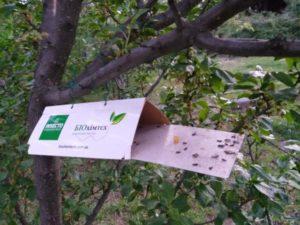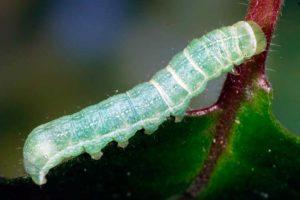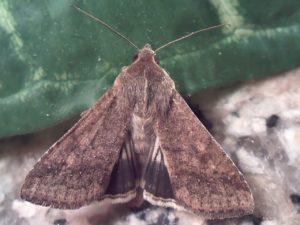Scoop garden pest: 6 ways to deal with insects
One of the most dangerous crop pests is the scoop. Each species damages different plants. Caterpillars destroy cabbage, corn, tomatoes, potatoes, beets, rye, wheat and many other crops. When insects appear, measures must be taken to destroy them.
Content
Photo scoops
Owl signs
butterfly scoop - one of the most common representatives of this family. She herself does not harm, only lays eggs, from which voracious larvae appear. They are harmful to plants. Depending on the type of pest, there are different methods of control. But there are also a number of general principles.
You can recognize the appearance immediately:
- visually - scoops are active at night, after dusk;
- during the day in bedding and mulch, on the inside of the leaves.
Owl control methods
Experts advise to proceed from the situation and choose the appropriate means. So, with a small infection and the first appearance of pests, you can get by with gentle folk methods.
When there are a lot of pests, you need to use comprehensive measures, quick and effective.
Traps
One of the real ways is to set pheromone traps. The trap determines the beginning of insect flight and the appearance of caterpillars. Initially, the flight coincided with the flowering period of dandelions. But every year the deadlines shifted and stretched. In this regard, the forecast is very important.
Natural enemies
Animals are attracted to the site that destroy the scoop.
Trichogramma - parasitic egg-eating insects, which are the natural enemies of the pest. They are artificially bred to eliminate scoop eggs.
predatory mites - Another natural enemy scoop. They destroy both larvae and adults of the insect pest. Often grown on purpose.
Birds. Not any particular species that feeds on scoops. But many are happy to eat different larvae and eggs. They are easy to attract - feeders.
Biological compounds
There are many biological substances on the market. It is appropriate to use special tools.
Chemical methods
Chemical preparations consist of neonicotinoids, pyrethroids, organophosphorus compounds. Most often they are combined.
Also effective means "Bazudin", "Shtefesin", "Dursban", "Fufafon", "Danadim".
Folk remedies
These methods include simple improvised means and herbal preparations. They last a little longer than others, but are safe. And besides, it's cheap.
1 kg of stems and leaves are boiled in 3 liters of water for 20 minutes. Spray plants. Harmless composition for people.
4 kg is boiled in 10 liters of water for half an hour. Then filtered, diluted with water in a ratio of 1:3 and used.
inflorescences and leaves (0,4 kg) are boiled in 10 liters of water for 30 minutes. 50 ml of liquid soap is added to the composition and sprayed.
1 kg of freshly cut plants are boiled for 30 minutes. Further cooled, filtered, processed.
Apply both fresh (1000 g) and dry (500 g). Boil for an hour in 10 liters of water. They insist for days. Dilute with water in a ratio of 1:8
Boil 50 g of dry powder in 1 liter of water and cool. Close tightly in container. Dilute in 20 liters of water. Planting material and affected plants are treated with this composition.
Cut the stems and leaves and pour 5 liters of water. After 3 days, add 50 g of liquid soap and spray.
100 g of inflorescences insist in 2 liters of water and process.
¼ onions insist for 12 hours, filter. Onions can be replaced with husks (7kg: 1l);
2 cloves insist in 1 liter of water for 4 days. Dilute with five parts of water and pollinate.
Cut off a flowering plant (1 kg) and add to a bucket of water. After 13 hours you can apply.
Useful mixtures
A number of components that act effectively on pests, in combination, give an amazing result.
| Wood ash, lime, tobacco | To pollinate the bushes, you must mix all the dry ingredients in the same amount. |
| Liquid soap and wood ash | 2 tablespoons of soap and 2 cups of ash are added to a bucket of water and spray the infected plantings. |
| Potassium permagnate | A glass of strong dark potassium permanganate is mixed with 10 liters of water - it has a disinfecting effect, fights bacteria and viruses. |
| Kerosene and soap | 750 ml of kerosene and 400 g of soap (it is advisable to choose household soap). Stir with 9 liters of water immediately before use. |
Preventive measures
Destroying caterpillars is not an easy process. To prevent their occurrence:
- alternate cultures;
- weeds are removed, as they are a forage base;
- they collect the pests that have appeared with their hands;
- with an increase in caterpillars, a drug is chosen for elimination;
- in case of ineffectiveness of previous means, chemical preparations are used;
- to fight butterflies lay eggshells between rows;
- baits in the form of sweet water are placed in small jars;
- basil and cilantro are planted so that their aromas repel pests;
- after harvesting, they dig a deep area to reduce the number of surviving insects.
Features of different types of scoops
All of the above methods work on the nocturnal scoop. But there are a number of features that must be taken into account when the fight is carried out with various types of pests.
The method of eliminating the nibbling scoop
Methods to deal with this variety include:
- digging the soil by more than 25 cm. This is done 2 times during the season. Usually before planting and after harvest. This method is effective against pupae and caterpillars;
- extraction and destruction of pests after loosening the rows;
- collection of weeds on the site and beyond;
- luring butterflies with kvass, compote, beer;
- application of soil insecticides against larvae.
Cotton bollworm destruction
This is a special quarantine type of scoop. The protective measures are:
- constant inspection of bushes, seedlings and seedlings.
Despite the fact that the cotton bollworm is omnivorous, it is necessary to carefully monitor the chrysanthemum, tomatoes, corn, roses, eggplants;
- using pheromone traps;
- fumigation if a pest appears.
Destruction of potato scoop and pepper
Features of the fight against these species can be called:
- cleaning of weed plants, especially among cereals;
- insecticide treatment of the soil and spraying of plants;
- prohibition of planting tomatoes next to potatoes due to the possibility of getting from one plant to another.
Fighting cabbage scoop
For prevention with a cabbage variety, be sure to:
- dig a deep area;
- make an early planting of seedlings in open ground to avoid damage to the sprouts;
- inspect and manually collect larvae and eggs;
- feed the cabbage seedling with superphosphate and potassium chloride.
Mass infection involves treatment with biological or folk insecticides. If there is no result, you can spray with a chemical.
Tomato scoop elimination method
The main step in the fight against tomato pests is the destruction of quinoa, white mari, nettle. Make sure they don't reappear.
Conclusion
There are a huge number of biological and chemical substances to fight scoops. Also, folk methods are no less effective. However, it is necessary to remember about preventive measures. By following all the tips, it will be possible to save time, effort and money for the fight against insects.
Previous



